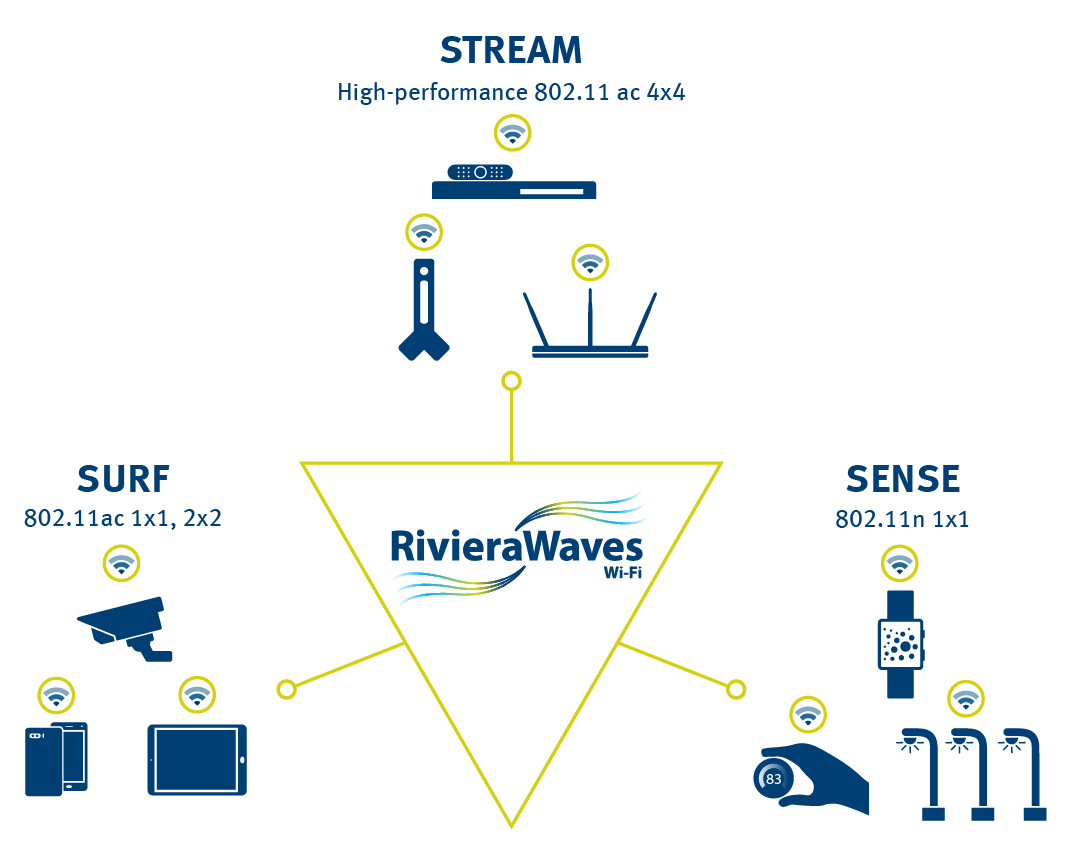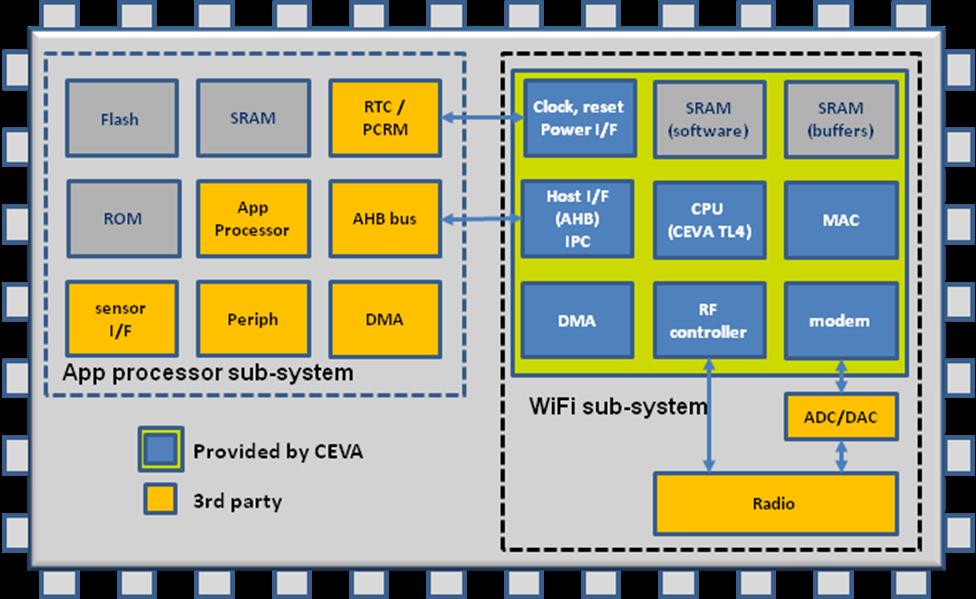Wearables are the new epitome of consumer chic, and while they are increasingly connected to the Internet, they come under the Internet of Things (IoT) fold. Wearable devices are ramping up faster than even smartphones and tablets with a CAGR of 154 percent (Source: Morgan Stanley, Wearable Device Blue Paper, Nov 2014).
Today we, at CEVA, unveiled a new family of RivieraWaves WiFi IP platforms—ranging from 802.11n 1×1 for various IoT devices all the way up to 802.11ac 4×4 for gateway and infrastructure products—allows system-on-chip (SoC) designers to seamlessly integrate Wi-Fi sockets into their chips with power and size efficiency.
CEVA offers the industry’s smallest Wi-Fi IPs for connected wearables, comprising of 802.11n 1×1 Full MAC and modem, which can be integrated with any RF IPs from various RF partners such as Catena or Maxscend. On the other end of the spectrum, for super-fast enterprise or public gateways, including for LTE networks offloading, CEVA offers Wi-Fi IP that boasts advanced features such as beam forming, multi-user MIMO (MU-MIMO), space-time block code (STBC), low density parity check (LDPC), dynamic bandwidth management, Wi-Fi Direct and WAPI.
MAC Plus Modem Platforms
The CEVA RivieraWaves Wi-Fi platforms comprise of MAC and PHY modem functions. The MAC is available as a hardware accelerator as well as software stacks in the form of Lower MAC (LMAC) and Upper MAC (UMAC). The LMAC constitutes what is often referred to as a SoftMAC or ThinMAC, leaving a lot of flexibility to the host application processor that executes the UMAC that is often already provided with the OS (ex: mac80211 on linux / Android). When combined together, the RivieraWaves LMAC and UMAC constitute a FullMAC solution. It’s worth noting that both LMAC and UMAC are processor and operating system (OS) agnostic.
Next, there are two modem options: hardwired modem and software defined modem (SDM). The hardwired modem is extremely low power and is optimized for minimal die area. The software modem brings greater flexibility for long life cycle and/or multi-standard connected devices by leveraging CEVA’s broad portfolio of DSP cores.

A CEVA-Powered Wi-Fi Chip Doesn’t Need an Application Processor and Works Seamlessly with Radio and Sensors
Three Wi-Fi Flavors
CEVA isn’t content with a one-size-fits-all solution and attempts to cover all the bases in the Wi-Fi network. The CEVA RivieraWaves Wi-Fi IP family comes in three flavors, and each one of them is designed to address specific end-product needs. All three flavors have been adopted by key semiconductor vendors worldwide.
RivieraWaves Sense: This 802.11n IP boasts the lowest power and the smallest footprint for the IoT products, including wearables, medical devices and wireless audio. The Sense IP, which features full MAC as well as hardwired and software defined modems, enables SoC designs that can operate for years on a single AA battery. A derivative of the RivieraWaves Sense IP to support 802.11ah is in the works and is expected to be available soon.
RivieraWaves Surf: This 802.11ac 1×1 and 2×2 IP is aimed at high bandwidth devices such as smartphones, tablets, and surveillance cameras. The solution, comprising of full MAC and hardwired modem, still consumes less power than competing 802.11n solutions.
RivieraWaves Stream: It’s the highest performance Wi-Fi IP that goes up to 4×4 802.11ac and is aimed at wireless infrastructure devices such as access points, media gateways and Wi-Fi offload in small cells. RivieraWaves Stream, which utilizes the processing power of the CEVA-XC DSP, offers high throughput of 1.7 Gbps for gateways in infrastructure applications. Moreover, it consumes less than 3.5W peak including RF for a complete 802.11ac 4×4 solution.

The RivieraWaves Wi-Fi IP family comes in three flavors, and each one of them is designed to address specific end-product needs
Wi-Fi and Bluetooth Combo
The IoT devices are getting wirelessly connected, mostly using Wi-Fi and Bluetooth, while ZigBee is getting far behind. One of the salient features of RivieraWaves Wi-Fi IP platforms is their peaceful co-existence with the Bluetooth products.
The CEVA RivieraWaves Bluetooth 4.2 IPs can be seamlessly integrated with Wi-Fi platforms through an interface that handles Wi-Fi and Bluetooth traffic arbitration to avoid interference. Take Apple Watch, for instance, which uses Bluetooth to connect to the iPhone, while it switches to Wi-Fi link to save power and speed up data transfer when needed.
Apple Watch uses a Wi-Fi 802.11n + Bluetooth combo chip from Broadcom that acquires the die size of 18.5mm2. However, the integration of Wi-Fi and Bluetooth functions onto Apple’s Application Processor Unit (APU) would have reduced the cost, power consumption and die size of the Apple Watch. For instance, a CEVA-plus-Catena 802.11ac and Bluetooth combo solution—a complete platform with MAC, modem, AFE, RF, CPU and memories—would have taken up just 6mm2 on Apple S1, saving roughly 70 percent in die size.
Smart RF Play
The CEVA RivieraWaves Wi-Fi IP platforms are highly flexible and can interface with any radio from various partners such as Catena and Maxscend. These RF IPs, available at a number of foundries and process nodes, provide SoC designers with a broad choice of RF options for their specific requirements. Moreover, the RivieraWaves Wi-Fi platforms can interface with a customer’s internal RF developments and can accommodate any selected RF solution.
The second largest chip after the APU in a smartwatch is the wireless chip. The CEVA RivieraWaves Wi-Fi IPs being very competitive in power efficiency and die size, an equivalent of the Broadcom BCM43342 wireless chip and based on CEVA-plus-Catena-RF could be very well integrated into the Apple APU with the benefit of less than one third of the BCM43342 die size. That is a key advantage for power and size sensitive products such as the Apple Watch.
Viable Choices for Designers
You can either integrate any of the CEVA Wi-Fi IP platforms with APU or MCU for a fully integrated SoC solution. Or you can develop a very low-cost standalone Wi-Fi chip where you don’t need an extra host application processor; CPUs like TeakLite-4 can execute that function.
That latter is a black-box solution that doesn’t require a CPU license. The TeakLite-4 DSP core takes care of full MAC and TCP/UDP protocol stacks. Moreover, it provides support for always-on sensing and audio processing applications (see Figure 2). The customer is anyway free to select any other CPU such as the ARM® Cortex-M™family ARC® EM family, AndesCore™ family, Cortus APS family and others.
For further information:
- Download “Wi-Fi in Wearable / IoT” presentation from Linley IoT Conference, June 11, 2015
- Visit RivieraWaves Wi-Fi product page
- Read EE Journal : WiFi Three Ways from CEVA by Bryon Moyer, August 28th




